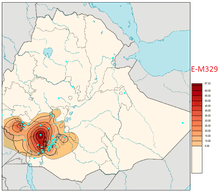Haplogroup E-M329
Haplogroup E-M329 is a haplogroup, a group of similar haplotypes that share a common ancestor with a single-nucleotide polymorphism mutation. It is defined by the SNP mutation M329.[Note 1] The majority of the cases observed have been found in East Africa. It has been found in ancient DNA isolated from a 4,500 year old Ethiopian fossil called Mota.[5][6][1] This haplogroup is frequent in Southwestern Ethiopia, especially among Omotic-speaking populations.[3][4] Semino et al. (2004) found 2 Ethiopian Oromo in a study of >2400 individuals, including 78 Oromo.[7] Cadenas et al. (2007) found 1 case in Qatar, out of 72 people tested there in that study.[8]
| Haplogroup E-M329 (former E3* / E1b1c) | |
|---|---|
| Possible time of origin | 39,400 years BP[1] |
| Coalescence age | 25,800 years BP[1] |
| Possible place of origin | Ethiopia [2] |
| Ancestor | E-V38 |
| Descendants | E-V2403, E-M329* |
| Defining mutations | M329 |
Genetics
Notes
- It was formerly known as E1b1c.
gollark: Apparently someone was naturally born with that, and didn't even horribly die, so it's probably safe to do.
gollark: I guess it would be nontrivial to do that in adults.
gollark: Can't you just remove the genes for myostatin?
gollark: https://media.discordapp.net/attachments/412764872816852994/899001509113626684/unknown.png
gollark: I even have it monitoring some things on my Discord bot.
References
- "E-M329 YTree". www.yfull.com.
- Trombetta, Beniamino; Fulvio Cruciani; Daniele Sellitto; Rosaria Scozzari (6 January 2011). MacAulay, Vincent (ed.). "A New Topology of the Human Y Chromosome Haplogroup E1b1 (E-P2) Revealed through the Use of Newly Characterized Binary Polymorphisms". PLoS ONE. 6 (1): e16073. doi:10.1371/journal.pone.0016073. PMC 3017091. PMID 21253605.
- "Plaster et al. Y-DNA E subclades predicted by Passa".
- C.A., Plaster (2011-09-28). "Variation in Y chromosome, mitochondrial DNA and labels of identity on Ethiopia". discovery.ucl.ac.uk. Retrieved 2018-06-27.
- http://science.sciencemag.org/content/suppl/2015/10/07/science.aad2879.DC1
- Llorente, M. Gallego; Jones, E. R.; Eriksson, A.; Siska, V.; Arthur, K. W.; Arthur, J. W.; Curtis, M. C.; Stock, J. T.; Coltorti, M. (2015-11-13). "Ancient Ethiopian genome reveals extensive Eurasian admixture in Eastern Africa". Science. 350 (6262): 820–822. doi:10.1126/science.aad2879. ISSN 0036-8075. PMID 26449472.
- Semino, Ornella; Magri, C; Benuzzi, G; Lin, AA; Al-Zahery, N; Battaglia, V; MacCioni, L; Triantaphyllidis, C; et al. (2004). "Origin, Diffusion, and Differentiation of Y-Chromosome Haplogroups E and J: Inferences on the Neolithization of Europe and Later Migratory Events in the Mediterranean Area". American Journal of Human Genetics. 74 (5): 1023–1034. doi:10.1086/386295. PMC 1181965. PMID 15069642.
- Cadenas, Alicia M.; Lev A Zhivotovsky, Luca L Cavalli-Sforza, Peter A Underhill and Rene J Herrera (10 October 2007). "Y-chromosome diversity characterizes the Gulf of Oman". European Journal of Human Genetics. 16 (3): 374–386. doi:10.1038/sj.ejhg.5201934. PMID 17928816.CS1 maint: multiple names: authors list (link)
This article is issued from Wikipedia. The text is licensed under Creative Commons - Attribution - Sharealike. Additional terms may apply for the media files.
